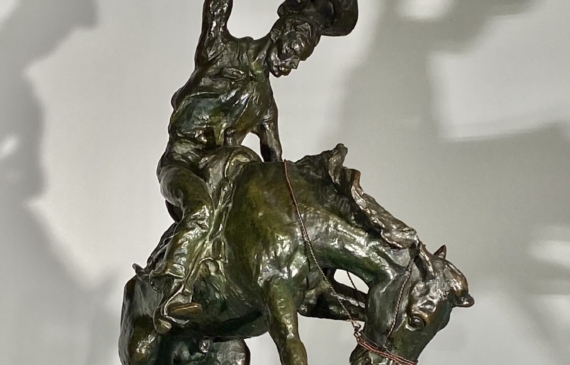





J. Clinton Shepherd
American, 1888-1975
Cowboy on a Bronc, 1922
Bronze, dark green and brown patina
19 ⅝ H. x 14 ¼ W. x 9 ½ D. inches
Signed on base: © 1922 / J. CLINTON SHEPHERD
Inscribed on base: ROMAN BRONZE WORKS N – Y –
Numbered underneath base: No. 7
J. Clinton Shepherd, sculptor, painter and illustrator, was born in Des Moines, Iowa, in 1888. He became an illustrator in New York, and then the Director of the Norton School of Art in Palm Beach, Florida from 1941 to 1946. His specialty was painting in realist style western subjects and animals.
Shepherd studied for two years at the University of Missouri, and then he and his brother, Donald, explored the Northwest, living with the Crow Indians where he learned their language and customs. It was during this period that he became interested in doing sculpture depicting Indians and western subjects.
During WW1 he joined the service, graduating from flight school, and he became a pilot in the Signal Corps, now the US Air Force. Following WWI, he attended art schools at The Chicago Institute, The Beaux Art Institute in Paris, and the Kansas City Art Institute, and among his teachers were Walter Ufer and Harvey Dunn.
He also had illustration work, doing covers for the Saturday Evening Post and Colliers magazine and also dust jackets and stories for Zane Grey novels and other novelists.
In 1928 he was commissioned by the City of Westport, Connecticut to do a monumental sculpture in honor of the 238 men and women from Westport who died during the war. The finished work, “Dough Boy”, stood 18 feet in height, and was located in the center part of the Post Road until 1988 when it was moved to the Westport town square.
Shepherd moved to Florida in 1938 to accept a position as Art Instructor at Barry College in Miami. After several years in that position, he moved to Palm Beach to become the first Director of the Norton Gallery School of Art in West Palm Beach.
He left that position to open his own studio in Palm Beach where he painted murals and portraits of the rich and famous.
One of his greatest works during that period was the 98-foot mural of the Everglades commissioned by the US Sugar Corporation in the Clewiston Inn, in Clewiston, Florida. He later did a mural in Thomasville, Georgia for the Poe Estate, which is now a public museum, and that mural, 132 inches in length, is the largest he ever painted
Shepherd was a member of the Palm Beach Art League, the National Sculpture Society and the Silvermine Art Guild. His work was exhibited at the National Academy of Design, the Pennsylvania Academy of the Fine Arts, the Norton Gallery, the Silvermine Artists Guild, the Miami Artist League and the Palm Beach Artist League.
J. Clinton Shepherd’s western bronzes are on exhibit in many museums throughout the US and Canada including The Birmingham Museum of Art, The R.W. Norton Museum in Shreveport, LA.; The Museum of Art and the Thomas Gilgrease Institute in Tulsa, The National Academy of Design and the Graham Gallery in New York City; the Pennsylvania Academy in Philadelphia; and the Glenbow-Alberta Institute in Calgary, Alberta.
Shepherd was often referred to as “Remington’s latest successor,” a term he found somewhat annoying.
He died in Palm Beach, Florida at age 86 and was in his studio, actively painting, at the time of his stroke from which he died two days later.